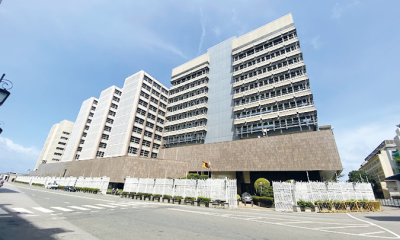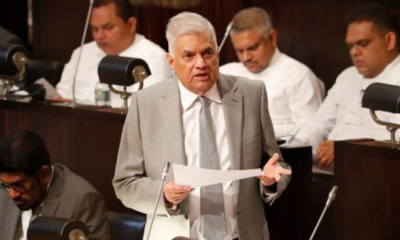Features
Budget, Taxation Turmoil and Policy Blunders – Part II

 Last week, we delved into a significant event in New Zealand, where a group of affluent individuals expressed a willingness to voluntarily pay more taxes, only to have the tax authority reject their offer. This incident prompts questions about the fairness of the current tax system, particularly in relation to the lower tax rates paid by the wealthiest citizens. Drawing parallels with Sri Lanka, the discussion advocates for the implementation of mandatory Tax Identification Numbers (TINs) in developing economies, underlining the necessity for a more equitable tax system.
Last week, we delved into a significant event in New Zealand, where a group of affluent individuals expressed a willingness to voluntarily pay more taxes, only to have the tax authority reject their offer. This incident prompts questions about the fairness of the current tax system, particularly in relation to the lower tax rates paid by the wealthiest citizens. Drawing parallels with Sri Lanka, the discussion advocates for the implementation of mandatory Tax Identification Numbers (TINs) in developing economies, underlining the necessity for a more equitable tax system.
We observed a unique situation in Sri Lanka where, despite per capita GDP growth, the tax-to-GDP ratio has been on a decline. The introduction of some naïve tax policies, such as the abolition of mandatory PAYE Tax, the increase in tax and VAT allowances, in 2019/2020, were also discussed.
The projection for Sri Lanka’s tax revenue as a percentage of GDP is expected to rise from 7.3% in 2022 to 12.1% in 2024, with the World Bank emphasizing the importance of maintaining tax revenues above 15% of GDP for economic growth. Projections for Sri Lanka’s GDP per Capita indicate a gradual increase over the next few years, reaching around US$4098.00 in 2025.
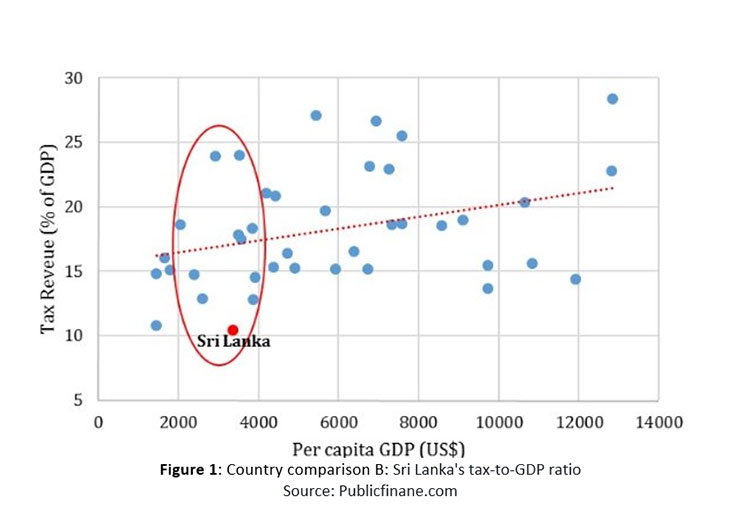
Sri Lanka compared
According to a map available on the Internet, depicting global comparison of Tax-to-GDP ratio, Sri Lanka is bracketed with several economically challenged African nations as well as Afghanistan and Bangladesh within its region. Notably, it ranks lower than many neighbouring countries including India, Nepal, Bhutan, Pakistan, and Indonesia etc.
On the contrary, countries with higher income levels, such as US, UK, Australia and any European countries, demonstrate considerably elevated tax-to-GDP ratios, ranging from 20% to 30%, and, in some cases such as UK France, the Netherlands, New Zealand and Denmark, reaching as high as 40% to 45%.
Figure 1 plots countries based on their GDP per capita and tax revenue as a percentage of GDP. Countries with income levels like Sri Lanka (ranging between US $2,000-4,000) are highlighted within the circle. Sri Lanka’s tax-to-GDP ratio falls significantly below the average. For instance, Morocco and Georgia, with GDP per capita figures of US $2,931 and US $3,529, respectively—comparable to Sri Lanka’s GDP per capita of US $3,369—both countries collect 24 percent of GDP as tax revenue, whereas Sri Lanka collects only 11 percent.
The tax revenue as a percentage of GDP for middle-income countries has shown a relatively stable trend over the years. The values range from around 10.7% in 2005 to an expected 11.4% in 2024 (Forecast).
Sri Lanka’s tax revenue as a percentage of GDP has experienced fluctuations during the period. Notable peaks are observed in 2006, 2007, and reaching up to 14.6% in 2015 and was par with the Middle-Income countries, followed by a decline again from 2019. The values have varied, with a dip to 7.8% in 2021, indicating a substantial decrease. Projections for 2022 and 2023 show a gradual increase, with the budget for 2024 aiming at a significant rise to 12.1%. (See Figure 2).
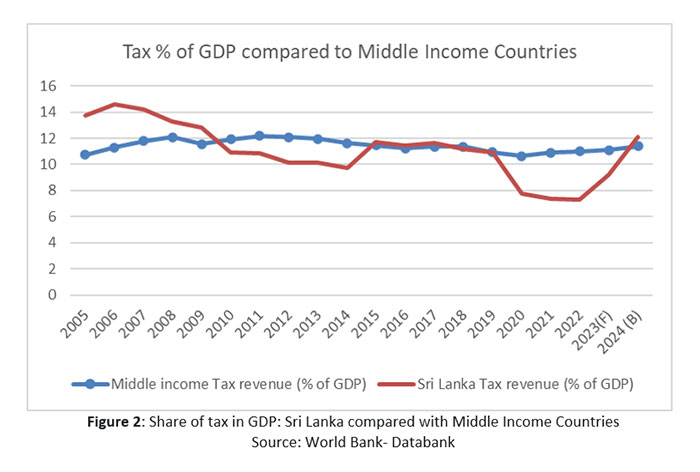
Hence, the tax revenue for Sri Lanka, while exhibiting fluctuations, generally appears to be on a recovery path after a notable decline in recent years. The budgeted figure for 2024 suggests an ambitious target, aiming for a substantial increase in tax revenue as a percentage of GDP.
Not only arbitrage but
also corruption
In countries like the United States, income tax stands out as the primary revenue source. This is facilitated by nearly zero import duties, typically set at 5 percent or less, and the absence of a value-added tax (VAT). In contrast, Europe relies heavily on a value-added tax, often around 20 percent, but does not impose import duties. In Sri Lanka, despite the relatively high import duties borne by the average citizen, the government only receives a fraction of this revenue. This is a result of the diversion of substantial sums to domestic protectionists through the practice of tax arbitrage, coupled with instances of tax avoidance (commonly referred to as tax minimization) and evasion, often involving manipulations and collusion.
Tax arbitrage involves exploiting differences in tax policies or rates across different jurisdictions to gain a financial advantage. In the context of domestic protectionists, individuals or entities within a country capitalize on tax differences among regions. This strategy often involves the strategic use of tax regulations or loopholes to minimize or entirely avoid tax liability. Notably, corruption plays a crucial role in this dynamic. Given the prevalent culture of corruption, extending from the top echelons of the state to even lower-level positions in Sri Lanka, these tactics can be readily implemented by astute business individuals, both on a large and small scale.
Not only anomaly but
also corruption
A noteworthy aberration in Sri Lanka’s tax structure is its disproportionate reliance on taxes related to international trade for tax revenue in comparison to its income level. Global patterns indicate that the proportion of taxes on imports as a share of total tax revenue tends to decrease as income levels rise. For instance, a study by Loewy, titled ‘Taxation: 21st Century Issues and Challenges’, revealed that trade taxes contribute to approximately 25% of total tax revenue in low-income countries, 12% in lower-middle-income countries, 9% in upper-middle-income countries, and less than one percent in high-income countries.
Contrary to these trends, in Sri Lanka’s case, taxes imposed solely on imports constitute nearly 20% of the government’s total tax revenue—a significantly high figure for a lower-middle-income country (Figure 3). The country’s substantial reliance on international trade for tax income has proven to be a risky proposition for the government. While restricting imports is essential to address the trade deficit, it comes at the cost of reduced government revenue and an exacerbated budget deficit. Conversely, increasing imports would boost government revenue but intensify the trade deficit. Consequently, a strategic shift away from trade-related taxes becomes crucial for the government to generate revenue without destabilizing the country’s macroeconomic environment.
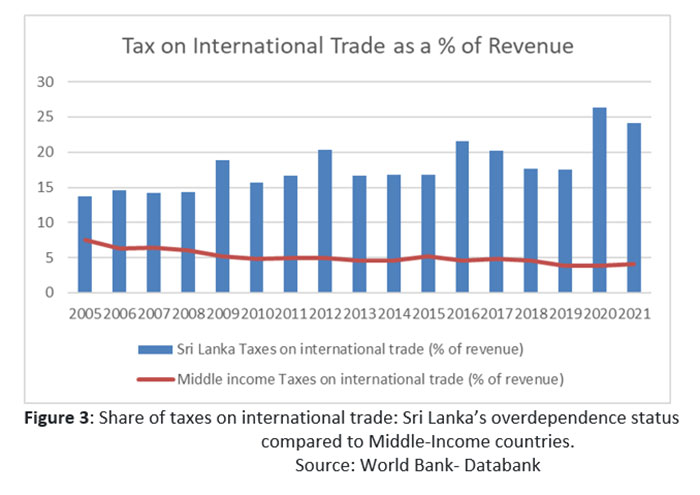
Share of expenses on government servants
Government spending in Sri Lanka was 48% in 2019 to public sector salaries and pensions but now only 44% allocated for 2024 as mentioned before. In the most recent budget presentation, over 35% of government expenditure was directed towards public sector salaries, pensions, and public welfare, emphasising their importance in government spending. In a specific breakdown, it is mentioned that Rs. 92 billion was allocated to pay the salaries of public sector employees in July 2022. Moreover, a historical perspective indicates the significance of government spending on salaries, dating back to 1950. Overall, public sector salaries and pensions play a crucial role in Sri Lanka’s government expenditure, reflecting a substantial commitment to the welfare of government employees.
Another anomaly is too many armed forces
Sri Lanka’s armed forces strength of 317,000 personnel is financially unsustainable because of its considerable annual expenditure of Rs.423 billion (410 in 2023), which is 1.88% of the GDP. Comparisons with other nations, including Australia and the Netherlands, reveal significantly smaller military forces. Sri Lanka’s post-civil war armed forces maintenance highlights the country’s unique revenue-based fiscal consolidation strategy, focusing on tax increases without traditional cost-cutting measures.
Conclusions
This analysis reveals three main anomalies in Sri Lanka’s tax structure, including a decline in taxpayers after significant tax cuts. The essay emphasizes the importance of sustaining tax revenues for economic growth and explores the country’s tax-to-GDP ratio, positioning it against global comparisons (over 15% of GDP). Notably, it highlights the overdependence on international trade taxes, the disproportionate spending on government servants, and the financial challenges posed by the substantial size and expenditure on the armed forces. The narrative suggests a need for strategic reforms to navigate the intricate fiscal landscape.
(The writer, a senior Chartered Accountant and professional banker, is Professor at SLIIT University, Malabe. He is also the author of the “Doing Social Research and Publishing Results”, a Springer publication (Singapore), and “Samaja Gaveshakaya (in Sinhala). The views and opinions expressed in this article are solely those of the author and do not necessarily reflect the official policy or position of the institution he works for.)
Features
The heart-friendly health minister

by Dr Gotabhya Ranasinghe
Senior Consultant Cardiologist
National Hospital Sri Lanka
When we sought a meeting with Hon Dr. Ramesh Pathirana, Minister of Health, he graciously cleared his busy schedule to accommodate us. Renowned for his attentive listening and deep understanding, Minister Pathirana is dedicated to advancing the health sector. His openness and transparency exemplify the qualities of an exemplary politician and minister.
Dr. Palitha Mahipala, the current Health Secretary, demonstrates both commendable enthusiasm and unwavering support. This combination of attributes makes him a highly compatible colleague for the esteemed Minister of Health.
Our discussion centered on a project that has been in the works for the past 30 years, one that no other minister had managed to advance.
Minister Pathirana, however, recognized the project’s significance and its potential to revolutionize care for heart patients.
The project involves the construction of a state-of-the-art facility at the premises of the National Hospital Colombo. The project’s location within the premises of the National Hospital underscores its importance and relevance to the healthcare infrastructure of the nation.
This facility will include a cardiology building and a tertiary care center, equipped with the latest technology to handle and treat all types of heart-related conditions and surgeries.
Securing funding was a major milestone for this initiative. Minister Pathirana successfully obtained approval for a $40 billion loan from the Asian Development Bank. With the funding in place, the foundation stone is scheduled to be laid in September this year, and construction will begin in January 2025.
This project guarantees a consistent and uninterrupted supply of stents and related medications for heart patients. As a result, patients will have timely access to essential medical supplies during their treatment and recovery. By securing these critical resources, the project aims to enhance patient outcomes, minimize treatment delays, and maintain the highest standards of cardiac care.
Upon its fruition, this monumental building will serve as a beacon of hope and healing, symbolizing the unwavering dedication to improving patient outcomes and fostering a healthier society.We anticipate a future marked by significant progress and positive outcomes in Sri Lanka’s cardiovascular treatment landscape within the foreseeable timeframe.
Features
A LOVING TRIBUTE TO JESUIT FR. ALOYSIUS PIERIS ON HIS 90th BIRTHDAY

by Fr. Emmanuel Fernando, OMI
Jesuit Fr. Aloysius Pieris (affectionately called Fr. Aloy) celebrated his 90th birthday on April 9, 2024 and I, as the editor of our Oblate Journal, THE MISSIONARY OBLATE had gone to press by that time. Immediately I decided to publish an article, appreciating the untiring selfless services he continues to offer for inter-Faith dialogue, the renewal of the Catholic Church, his concern for the poor and the suffering Sri Lankan masses and to me, the present writer.
It was in 1988, when I was appointed Director of the Oblate Scholastics at Ampitiya by the then Oblate Provincial Fr. Anselm Silva, that I came to know Fr. Aloy more closely. Knowing well his expertise in matters spiritual, theological, Indological and pastoral, and with the collaborative spirit of my companion-formators, our Oblate Scholastics were sent to Tulana, the Research and Encounter Centre, Kelaniya, of which he is the Founder-Director, for ‘exposure-programmes’ on matters spiritual, biblical, theological and pastoral. Some of these dimensions according to my view and that of my companion-formators, were not available at the National Seminary, Ampitiya.
Ever since that time, our Oblate formators/ accompaniers at the Oblate Scholasticate, Ampitiya , have continued to send our Oblate Scholastics to Tulana Centre for deepening their insights and convictions regarding matters needed to serve the people in today’s context. Fr. Aloy also had tried very enthusiastically with the Oblate team headed by Frs. Oswald Firth and Clement Waidyasekara to begin a Theologate, directed by the Religious Congregations in Sri Lanka, for the contextual formation/ accompaniment of their members. It should very well be a desired goal of the Leaders / Provincials of the Religious Congregations.
Besides being a formator/accompanier at the Oblate Scholasticate, I was entrusted also with the task of editing and publishing our Oblate journal, ‘The Missionary Oblate’. To maintain the quality of the journal I continue to depend on Fr. Aloy for his thought-provoking and stimulating articles on Biblical Spirituality, Biblical Theology and Ecclesiology. I am very grateful to him for his generous assistance. Of late, his writings on renewal of the Church, initiated by Pope St. John XX111 and continued by Pope Francis through the Synodal path, published in our Oblate journal, enable our readers to focus their attention also on the needed renewal in the Catholic Church in Sri Lanka. Fr. Aloy appreciated very much the Synodal path adopted by the Jesuit Pope Francis for the renewal of the Church, rooted very much on prayerful discernment. In my Religious and presbyteral life, Fr.Aloy continues to be my spiritual animator / guide and ongoing formator / acccompanier.
Fr. Aloysius Pieris, BA Hons (Lond), LPh (SHC, India), STL (PFT, Naples), PhD (SLU/VC), ThD (Tilburg), D.Ltt (KU), has been one of the eminent Asian theologians well recognized internationally and one who has lectured and held visiting chairs in many universities both in the West and in the East. Many members of Religious Congregations from Asian countries have benefited from his lectures and guidance in the East Asian Pastoral Institute (EAPI) in Manila, Philippines. He had been a Theologian consulted by the Federation of Asian Bishops’ Conferences for many years. During his professorship at the Gregorian University in Rome, he was called to be a member of a special group of advisers on other religions consulted by Pope Paul VI.
Fr. Aloy is the author of more than 30 books and well over 500 Research Papers. Some of his books and articles have been translated and published in several countries. Among those books, one can find the following: 1) The Genesis of an Asian Theology of Liberation (An Autobiographical Excursus on the Art of Theologising in Asia, 2) An Asian Theology of Liberation, 3) Providential Timeliness of Vatican 11 (a long-overdue halt to a scandalous millennium, 4) Give Vatican 11 a chance, 5) Leadership in the Church, 6) Relishing our faith in working for justice (Themes for study and discussion), 7) A Message meant mainly, not exclusively for Jesuits (Background information necessary for helping Francis renew the Church), 8) Lent in Lanka (Reflections and Resolutions, 9) Love meets wisdom (A Christian Experience of Buddhism, 10) Fire and Water 11) God’s Reign for God’s poor, 12) Our Unhiddden Agenda (How we Jesuits work, pray and form our men). He is also the Editor of two journals, Vagdevi, Journal of Religious Reflection and Dialogue, New Series.
Fr. Aloy has a BA in Pali and Sanskrit from the University of London and a Ph.D in Buddhist Philosophy from the University of Sri Lankan, Vidyodaya Campus. On Nov. 23, 2019, he was awarded the prestigious honorary Doctorate of Literature (D.Litt) by the Chancellor of the University of Kelaniya, the Most Venerable Welamitiyawe Dharmakirthi Sri Kusala Dhamma Thera.
Fr. Aloy continues to be a promoter of Gospel values and virtues. Justice as a constitutive dimension of love and social concern for the downtrodden masses are very much noted in his life and work. He had very much appreciated the commitment of the late Fr. Joseph (Joe) Fernando, the National Director of the Social and Economic Centre (SEDEC) for the poor.
In Sri Lanka, a few religious Congregations – the Good Shepherd Sisters, the Christian Brothers, the Marist Brothers and the Oblates – have invited him to animate their members especially during their Provincial Congresses, Chapters and International Conferences. The mainline Christian Churches also have sought his advice and followed his seminars. I, for one, regret very much, that the Sri Lankan authorities of the Catholic Church –today’s Hierarchy—- have not sought Fr.
Aloy’s expertise for the renewal of the Catholic Church in Sri Lanka and thus have not benefited from the immense store of wisdom and insight that he can offer to our local Church while the Sri Lankan bishops who governed the Catholic church in the immediate aftermath of the Second Vatican Council (Edmund Fernando OMI, Anthony de Saram, Leo Nanayakkara OSB, Frank Marcus Fernando, Paul Perera,) visited him and consulted him on many matters. Among the Tamil Bishops, Bishop Rayappu Joseph was keeping close contact with him and Bishop J. Deogupillai hosted him and his team visiting him after the horrible Black July massacre of Tamils.
Features
A fairy tale, success or debacle

Sri Lanka-Singapore Free Trade Agreement
By Gomi Senadhira
senadhiragomi@gmail.com
“You might tell fairy tales, but the progress of a country cannot be achieved through such narratives. A country cannot be developed by making false promises. The country moved backward because of the electoral promises made by political parties throughout time. We have witnessed that the ultimate result of this is the country becoming bankrupt. Unfortunately, many segments of the population have not come to realize this yet.” – President Ranil Wickremesinghe, 2024 Budget speech
Any Sri Lankan would agree with the above words of President Wickremesinghe on the false promises our politicians and officials make and the fairy tales they narrate which bankrupted this country. So, to understand this, let’s look at one such fairy tale with lots of false promises; Ranil Wickremesinghe’s greatest achievement in the area of international trade and investment promotion during the Yahapalana period, Sri Lanka-Singapore Free Trade Agreement (SLSFTA).
It is appropriate and timely to do it now as Finance Minister Wickremesinghe has just presented to parliament a bill on the National Policy on Economic Transformation which includes the establishment of an Office for International Trade and the Sri Lanka Institute of Economics and International Trade.
Was SLSFTA a “Cleverly negotiated Free Trade Agreement” as stated by the (former) Minister of Development Strategies and International Trade Malik Samarawickrama during the Parliamentary Debate on the SLSFTA in July 2018, or a colossal blunder covered up with lies, false promises, and fairy tales? After SLSFTA was signed there were a number of fairy tales published on this agreement by the Ministry of Development Strategies and International, Institute of Policy Studies, and others.
However, for this article, I would like to limit my comments to the speech by Minister Samarawickrama during the Parliamentary Debate, and the two most important areas in the agreement which were covered up with lies, fairy tales, and false promises, namely: revenue loss for Sri Lanka and Investment from Singapore. On the other important area, “Waste products dumping” I do not want to comment here as I have written extensively on the issue.
1. The revenue loss
During the Parliamentary Debate in July 2018, Minister Samarawickrama stated “…. let me reiterate that this FTA with Singapore has been very cleverly negotiated by us…. The liberalisation programme under this FTA has been carefully designed to have the least impact on domestic industry and revenue collection. We have included all revenue sensitive items in the negative list of items which will not be subject to removal of tariff. Therefore, 97.8% revenue from Customs duty is protected. Our tariff liberalisation will take place over a period of 12-15 years! In fact, the revenue earned through tariffs on goods imported from Singapore last year was Rs. 35 billion.
The revenue loss for over the next 15 years due to the FTA is only Rs. 733 million– which when annualised, on average, is just Rs. 51 million. That is just 0.14% per year! So anyone who claims the Singapore FTA causes revenue loss to the Government cannot do basic arithmetic! Mr. Speaker, in conclusion, I call on my fellow members of this House – don’t mislead the public with baseless criticism that is not grounded in facts. Don’t look at petty politics and use these issues for your own political survival.”
I was surprised to read the minister’s speech because an article published in January 2018 in “The Straits Times“, based on information released by the Singaporean Negotiators stated, “…. With the FTA, tariff savings for Singapore exports are estimated to hit $10 million annually“.
As the annual tariff savings (that is the revenue loss for Sri Lanka) calculated by the Singaporean Negotiators, Singaporean $ 10 million (Sri Lankan rupees 1,200 million in 2018) was way above the rupees’ 733 million revenue loss for 15 years estimated by the Sri Lankan negotiators, it was clear to any observer that one of the parties to the agreement had not done the basic arithmetic!
Six years later, according to a report published by “The Morning” newspaper, speaking at the Committee on Public Finance (COPF) on 7th May 2024, Mr Samarawickrama’s chief trade negotiator K.J. Weerasinghehad had admitted “…. that forecasted revenue loss for the Government of Sri Lanka through the Singapore FTA is Rs. 450 million in 2023 and Rs. 1.3 billion in 2024.”
If these numbers are correct, as tariff liberalisation under the SLSFTA has just started, we will pass Rs 2 billion very soon. Then, the question is how Sri Lanka’s trade negotiators made such a colossal blunder. Didn’t they do their basic arithmetic? If they didn’t know how to do basic arithmetic they should have at least done their basic readings. For example, the headline of the article published in The Straits Times in January 2018 was “Singapore, Sri Lanka sign FTA, annual savings of $10m expected”.
Anyway, as Sri Lanka’s chief negotiator reiterated at the COPF meeting that “…. since 99% of the tariffs in Singapore have zero rates of duty, Sri Lanka has agreed on 80% tariff liberalisation over a period of 15 years while expecting Singapore investments to address the imbalance in trade,” let’s turn towards investment.
Investment from Singapore
In July 2018, speaking during the Parliamentary Debate on the FTA this is what Minister Malik Samarawickrama stated on investment from Singapore, “Already, thanks to this FTA, in just the past two-and-a-half months since the agreement came into effect we have received a proposal from Singapore for investment amounting to $ 14.8 billion in an oil refinery for export of petroleum products. In addition, we have proposals for a steel manufacturing plant for exports ($ 1 billion investment), flour milling plant ($ 50 million), sugar refinery ($ 200 million). This adds up to more than $ 16.05 billion in the pipeline on these projects alone.
And all of these projects will create thousands of more jobs for our people. In principle approval has already been granted by the BOI and the investors are awaiting the release of land the environmental approvals to commence the project.
I request the Opposition and those with vested interests to change their narrow-minded thinking and join us to develop our country. We must always look at what is best for the whole community, not just the few who may oppose. We owe it to our people to courageously take decisions that will change their lives for the better.”
According to the media report I quoted earlier, speaking at the Committee on Public Finance (COPF) Chief Negotiator Weerasinghe has admitted that Sri Lanka was not happy with overall Singapore investments that have come in the past few years in return for the trade liberalisation under the Singapore-Sri Lanka Free Trade Agreement. He has added that between 2021 and 2023 the total investment from Singapore had been around $162 million!
What happened to those projects worth $16 billion negotiated, thanks to the SLSFTA, in just the two-and-a-half months after the agreement came into effect and approved by the BOI? I do not know about the steel manufacturing plant for exports ($ 1 billion investment), flour milling plant ($ 50 million) and sugar refinery ($ 200 million).
However, story of the multibillion-dollar investment in the Petroleum Refinery unfolded in a manner that would qualify it as the best fairy tale with false promises presented by our politicians and the officials, prior to 2019 elections.
Though many Sri Lankans got to know, through the media which repeatedly highlighted a plethora of issues surrounding the project and the questionable credentials of the Singaporean investor, the construction work on the Mirrijiwela Oil Refinery along with the cement factory began on the24th of March 2019 with a bang and Minister Ranil Wickremesinghe and his ministers along with the foreign and local dignitaries laid the foundation stones.
That was few months before the 2019 Presidential elections. Inaugurating the construction work Prime Minister Ranil Wickremesinghe said the projects will create thousands of job opportunities in the area and surrounding districts.
The oil refinery, which was to be built over 200 acres of land, with the capacity to refine 200,000 barrels of crude oil per day, was to generate US$7 billion of exports and create 1,500 direct and 3,000 indirect jobs. The construction of the refinery was to be completed in 44 months. Four years later, in August 2023 the Cabinet of Ministers approved the proposal presented by President Ranil Wickremesinghe to cancel the agreement with the investors of the refinery as the project has not been implemented! Can they explain to the country how much money was wasted to produce that fairy tale?
It is obvious that the President, ministers, and officials had made huge blunders and had deliberately misled the public and the parliament on the revenue loss and potential investment from SLSFTA with fairy tales and false promises.
As the president himself said, a country cannot be developed by making false promises or with fairy tales and these false promises and fairy tales had bankrupted the country. “Unfortunately, many segments of the population have not come to realize this yet”.
(The writer, a specialist and an activist on trade and development issues . )




